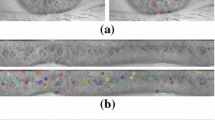Abstract
SIFT is a novel and promising method for iris recognition. However, some shortages exist in many related methods, such as difficulty of feature extraction, feature loss, and noise point introduction. In this paper, a new method named SIFT-based iris recognition with normalization and enhancement is proposed for achieving better performance. In Comparison with other SIFT-based iris recognition algorithms, the proposed method can overcome the difficulties of extreme point extraction and exclude the noise points without feature loss. Experimental results demonstrate that the normalization and enhancement steps are crucial for SIFT-based iris recognition, and the proposed method can achieve satisfactory recognition performance.









Similar content being viewed by others
References
Daugman J (1993) High confidence visual recognition of persons by a test of statistical independence. IEEE Trans Pattern Anal Mach Intell 15(11):1148–1161
Daugman J (2001) Statistical richness of visual phase information: update on recognizing persons by iris patterns. Int J Comput Vis 45(1):25–38
Wildes RP, Asmuth JC, Green GL, Hsu SC, Kolczynski RJ, Matey JR, McBride SE (1996) A machine-vision system for iris recognition. Mach Vis Appl 9:1–8
Boles WW, Boashash B (1998) A human identification technique using images of the iris and wavelet transform. IEEE Trans Signal Process 46(4):1185–1188
Ma L, Tan T, Wang Y, Zhang D (2003) Personal identification based on iris texture analysis. IEEE Trans Pattern Anal Mach Intell 25(12):1519–1533
Ma L, Tan T, Zhang D, Wang Y (2004) Local intensity variation analysis for iris recognition. Pattern Recognit 37(6):1287–1298
Partio M, Cramariuc B, Gabbouj M (2004) Texture similarity evaluation using ordinal co-occurrence. In: Proceedings of the IEEE international conference on image processing, Singapore, pp 1537–1540
Tisse C, Martin L, Torres L, Robert M (2002) Person identification technique using human iris recognition. In: Proceedings of the international conference on vision interface, pp 294–299
Huang J, Ma L, Wang Y, Tan T (2004) Iris recognition based on local orientation description. In: Proceedings of the sixth Asian conference on computer vision, vol 2, Korea, pp 954–959
Noh S, Bae K, Kim J (2003) A novel method to extract features for iris recognition system. In: Proceedings of the fourth international conference on audio- and video-based biometric person authentication, Guildford, pp 838–844
Sanchez-Avila C, Sanchez-Reillo R (2005) Two different approaches for iris recognition using gabor filters and multiscale zero-crossing representation. Pattern Recognit 38(2):231–240
Park C, Lee J, Smith M, Park K (2003) Iris-based personal authentication using a normalized directional energy feature. In: Proceedings of the fourth international conference on audio-and video-based biometric person authentication, Guildford, pp 224–232
Lim S, Lee K, Byeon O, Kim T (2001) Efficient iris recognition through improvement of feature vector and classifier. ETRIJ 23(2):61–70
Thornton J, Savvides M, Kumar V (2007) A bayesian approach to deformed pattern matching of iris images. IEEE Trans Pattern Anal Mach Intell 29(4):596–606
Cui J, Wang Y, Tan T, Ma L, Sun Z (2004) An iris recognition algorithm using local extreme points. In: Proceedings of the first international conference on biometric authentication, Hong Kong, pp 442–449
Monro DM, Rakshit S, Zhang D (2007) DCT-based iris recognition. IEEE Trans Pattern Anal Mach Intell 29(4):586–595
Sun Z, Wang Y, Tan T, and Cui J (2004) Robust direction estimation of gradient vector field for iris recognition. In: Proceedings of the 17th international conference on pattern recognition, vol 2, Cambridge, pp 783–786
Mojtaba N, Sedigheh G (2011) Iris recognition based on using ridgelet and curvelet transform. Int J Signal Process Image Process Pattern Recognit 4(2):7–18
Lowe DG (2004) Distinctive image features from scale-invariant keypoints. Int J Comput Vis 60(2):91–110
Zhu R, Yang J, Wu R (2006) Iris recognition based on local feature point matching. In: International symposium on communications and information technologies, Bangkok, pp 451–454
Belcher C, Du Y (2009) Region-based SIFT approach to iris recognition. Opt Lasers Eng 47(1):139–147
Wang L, Yang G, Yin Y (2010) Fast iris localization based on improved hough transform. In: Proceedings of RSKT’2010, Beijing, pp 439–446
Xu X, Liu W, Venkatesh S (2011) An innovative face image enhancement based on principle component analysis. Int J Mach Learn Cybern. doi:10.1007/s13042-011-0060-x
Bruce P, Amin MA, Yan H (2011) Performance evaluation and comparison of PCA Based human face recognition methods for distorted images. Int J Mach Learn Cybern 2(4):245–259
CASIA Iris Image Database. http://biometrics.idealtest.org
Acknowledgments
This work is supported by National Natural Science Foundation of China under Grant No. 61173069 and 61070097, and Shandong Province Higher Educational Science and Technology Program under Grant No. J11LG28. The authors would like to thank Wei Qin and Shuaiqiang Wang for their helpful comments and constructive advices on structuring the paper.
Author information
Authors and Affiliations
Corresponding author
Rights and permissions
About this article
Cite this article
Yang, G., Pang, S., Yin, Y. et al. SIFT based iris recognition with normalization and enhancement. Int. J. Mach. Learn. & Cyber. 4, 401–407 (2013). https://doi.org/10.1007/s13042-012-0101-0
Received:
Accepted:
Published:
Issue Date:
DOI: https://doi.org/10.1007/s13042-012-0101-0




